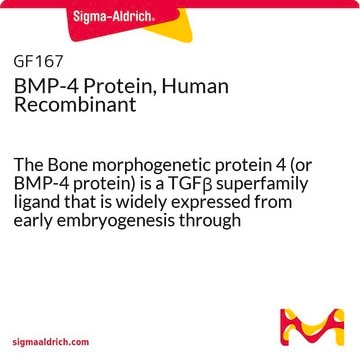H4916
Bone Morphogenetic Protein 4 human
BMP-4, recombinant, expressed in HEK 293 cells, HumanKine®, suitable for cell culture
Sinónimos:
BMP-4
About This Item
Productos recomendados
origen biológico
human
Nivel de calidad
recombinante
expressed in HEK 293 cells
Análisis
>95% (SDS-PAGE)
formulario
lyophilized powder
potencia
≤10 ng/mL EC50
calidad
endotoxin tested
mol peso
dimer 34 kDa (glycosylated)
envase
pkg of 10 μg
pkg of 100 μg
pkg of 1000 μg
condiciones de almacenamiento
avoid repeated freeze/thaw cycles
técnicas
cell culture | mammalian: suitable
impurezas
<1 EU/μg Endotoxin level
Nº de acceso UniProt
temp. de almacenamiento
−20°C
Información sobre el gen
human ... BMP4(652)
¿Está buscando productos similares? Visita Guía de comparación de productos
Descripción general
Aplicación
Acciones bioquímicas o fisiológicas
Cellular responses to BMP-4 are mediated by the formation of hetero-oligomeric complexes of type I and type II serine/threonine kinase receptors, which play significant roles in BMP binding and signaling. Two BMP type I receptors and one BMP type II receptor have been identified. Both BMP type I receptors bind BMP-4 with high-affinity in the absence of BMP receptor type II.
Forma física
Nota de preparación
Nota de análisis
Información legal
inhibidor
producto comparable
Código de clase de almacenamiento
11 - Combustible Solids
Clase de riesgo para el agua (WGK)
WGK 3
Punto de inflamabilidad (°F)
Not applicable
Punto de inflamabilidad (°C)
Not applicable
Certificados de análisis (COA)
Busque Certificados de análisis (COA) introduciendo el número de lote del producto. Los números de lote se encuentran en la etiqueta del producto después de las palabras «Lot» o «Batch»
¿Ya tiene este producto?
Encuentre la documentación para los productos que ha comprado recientemente en la Biblioteca de documentos.
Los clientes también vieron
Nuestro equipo de científicos tiene experiencia en todas las áreas de investigación: Ciencias de la vida, Ciencia de los materiales, Síntesis química, Cromatografía, Analítica y muchas otras.
Póngase en contacto con el Servicio técnico













